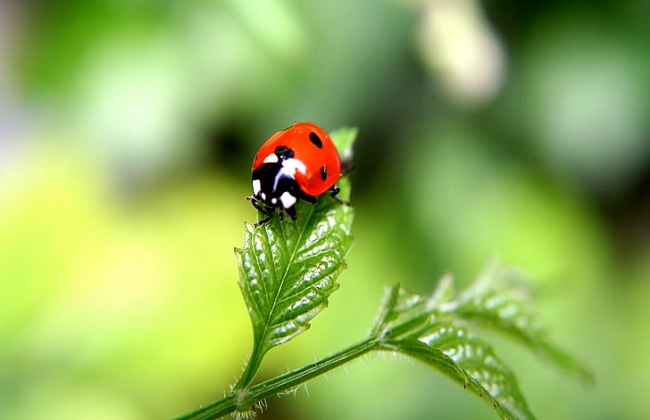For pest management, allow them into your yard, and say goodbye to chemical pesticides.
These tiny insects, often known as ladybirds, are easily recognized by their bright orange-red colour and tiny black dots. Some species have no spots, while others are entirely black or black with red spots.
They are valuable to gardeners because aphids are their favorite meal. These squishy bugs hinder plant growth and interfere with fruit set by sucking plant juices from vulnerable portions of the plant like growing tips and emerging buds.
Ladybugs and their larvae feed on a variety of insects in addition to aphids. Pests include Colorado potato beetle’s eggs and larvae, as well as mealybugs and spider mites.
How To Attract Ladybugs To Your Garden?
Avoid the use of chemical sprays
Mild insecticides have little effect on ladybug beetles, but they may prefer to avoid places that have been sprayed. For at least five to six weeks, you may notice some re-entering your garden on their own if you stop using all chemical control techniques, including herbicides and organic insecticides.
During the spring, when they emerge from hibernation in search of new food sites, this is more likely to occur.
Grow aphid-prone plants
Roses are notorious for attracting aphids. Another pair of ornamentals that are susceptible to significant infestations are nasturtium and pot marigold.
Aphids are drawn to vegetables such as cabbage and lettuce as well as fruits such as apples and oranges. The ladybugs will thank you if you plant a few of these in your garden.

Plant pollen and nectar-producing plants
Ladybugs may be carnivorous, but they also enjoy a bit of pollen and nectar when they’re still young.
Plants of the Umbelliferae family appear to attract ladybugs, according to this study. Dill, fennel, wild carrot, caraway, and cilantro are just a few examples. Tansy and yarrow, both members of the Asteraceae family, have flat flower heads packed with small pollen-rich blooms.

How To Buy and Release Ladybugs In The Garden
You can buy these ladybug beetles and release them in your garden if you are unable to attract native ladybugs or if a tiny colony is taking too long to establish.
However, before inviting guests, make sure your garden has been made insect-friendly so that they don’t flee for greener pastures.
Gardeners can save money by purchasing ladybugs. However, when released into the garden, ladybugs that have been bred in insect farms do not always follow the natural eating patterns.
As a result, the specimens sold by insect merchants are always taken from the wild, typically from aestivation and hibernation places where they gather in huge numbers.
Spray a little water into the bags as soon as you receive the beetles and put them in the refrigerator. Shipping might induce dehydration and overexcitement, thus this helps alleviate these symptoms. They find it easier to relax in a cool environment because it gives them the impression of being in hibernation.
Ladybugs can be kept in the refrigerator for up to three months. Because of this, it may appear that they have died. Some loss is to be expected, but most of them soon recover after being put into the garden.
Make sure there are at least a few aphid-infested plants in the area where you wish to release the ladybugs. The aphids’ perch will be knocked down by watering the plants, which will allow them to feed on the ground. It’s a win-win situation for both.
Ladybugs do best when released in the late evening or early morning. When they are released, the darkness and the cool temperature may keep them from escaping.
Sunlight, on the other hand, immediately causes them to fly away. If you release them in the evening, they will have the entire night to settle in.

How to Keep Ladybugs in Your Garden After They Have Been Introduced
Do not release the entire bag of ladybugs at once into the garden. You don’t want them all to flee at once, leaving you with nothing. Watch how they react when you remove a few thousand at a time. They tend to stay close to where they know they’ll be able to get food.
Inspect your neighbour’s garden if they seem to be heading there, and note what kinds of plants they seem to be attracted to. Keeping the same plants in your garden may help you maintain them there.
They may be able to lay at least one batch of eggs if you spray them with a sugar solution like soda diluted with equal parts water.
It’s possible that the drying sugar on the beetles will glue their wings together, preventing them from flying. In a week or two, the effect is gone, thus there is no long-term damage.
To protect the plants from the aphids, some people use cloches to cover them. As long as the infection isn’t too bad, the guests may stay put and feast on the infested food, laying eggs in the process.
Ladybugs can be helpful in a variety of situations, but the two most commonly seen commercially in the United States and Asia are Hippodamia convergens and Harmonia axyridis. Dealers may easily gather both of these because they are aggregating types.
Even while both species are effective pest controllers, the Asian kind is thought to be the more vicious predator. However, it may be better for your garden and the ecosystem if you invest in native beetles. In addition, Harmonia ladybugs tend to congregate in warm places and have been observed swarming into houses in search of warmth.

